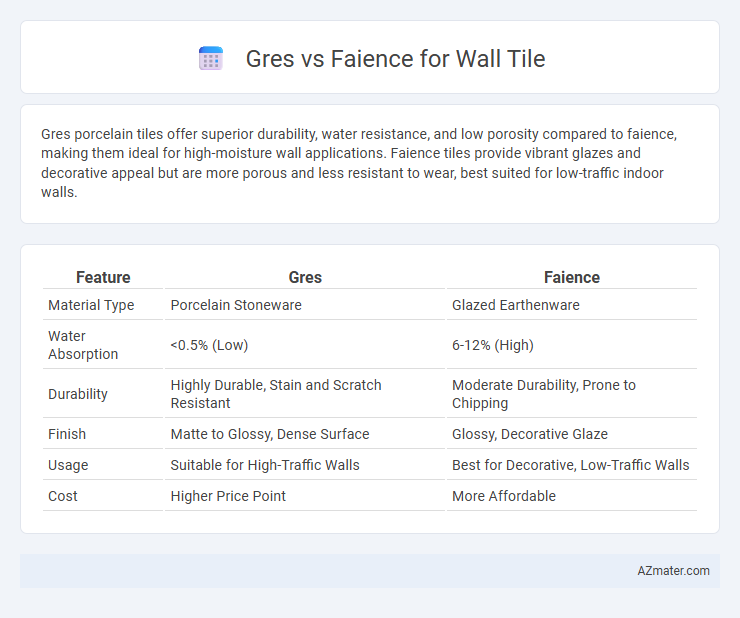Gres porcelain tiles offer superior durability, water resistance, and low porosity compared to faience, making them ideal for high-moisture wall applications. Faience tiles provide vibrant glazes and decorative appeal but are more porous and less resistant to wear, best suited for low-traffic indoor walls.
Table of Comparison
| Feature | Gres | Faience |
|---|---|---|
| Material Type | Porcelain Stoneware | Glazed Earthenware |
| Water Absorption | <0.5% (Low) | 6-12% (High) |
| Durability | Highly Durable, Stain and Scratch Resistant | Moderate Durability, Prone to Chipping |
| Finish | Matte to Glossy, Dense Surface | Glossy, Decorative Glaze |
| Usage | Suitable for High-Traffic Walls | Best for Decorative, Low-Traffic Walls |
| Cost | Higher Price Point | More Affordable |
Understanding Gres and Faience: Key Differences
Gres and faience are distinct ceramic materials used for wall tiles, with gres being a dense, durable porcelain tile known for its low porosity and high resistance to moisture and stains. Faience, on the other hand, is a glazed earthenware tile characterized by its vibrant colors and decorative finishes but is more porous and less durable than gres. Understanding these key differences helps in selecting the right tile based on durability, aesthetic needs, and installation area.
Composition and Manufacturing Processes
Gres tiles, made from dense, vitrified porcelain clay, undergo high-temperature firing that enhances durability and water resistance, making them ideal for heavy-duty wall applications. Faience tiles consist primarily of a porous earthenware clay with a tin-based glaze, fired at lower temperatures, resulting in a more decorative but less durable surface. The distinct compositions and firing methods critically influence their suitability for wall tiles, where gres offers robustness and faience provides ornamental appeal.
Aesthetic Variations: Colors, Patterns, and Finishes
Gres wall tiles offer a sleek, contemporary aesthetic with available colors ranging from muted neutrals to deep charcoal, often featuring subtle textures that mimic natural stone or concrete. In contrast, faience tiles are celebrated for vibrant, glossy finishes and intricate patterns, frequently adorned with hand-painted motifs or traditional designs that add a decorative flair. Both materials provide diverse options, but gres excels in minimalist and modern styles, while faience is ideal for rich, artistic expressions in wall decor.
Durability and Strength Comparison
Gres wall tiles exhibit exceptional durability and strength due to their dense, non-porous composition, making them highly resistant to cracks, scratches, and moisture absorption. Faience tiles, while visually appealing with their glazed finish, are more prone to chipping and less durable under heavy wear and exposure to moisture. The superior toughness and lower porosity of gres tiles make them ideal for high-traffic and wet areas, outperforming faience in long-term resilience and maintenance ease.
Water and Stain Resistance
Gres tiles exhibit superior water and stain resistance due to their dense, low-porosity composition, making them ideal for high-moisture environments and easy to maintain. Faience tiles, while visually appealing with their glazed surface, tend to have higher porosity underneath, which can lead to water absorption and greater susceptibility to staining over time. For long-lasting durability and minimal upkeep in areas prone to moisture, gres tiles outperform faience in resistance to water and stains.
Application Suitability: Best Uses for Walls
Gres wall tiles, made from dense, vitrified porcelain, offer exceptional durability and water resistance, making them ideal for high-traffic and moisture-prone areas such as kitchens, bathrooms, and commercial spaces. Faience tiles, characterized by their glazed earthenware composition, provide vibrant colors and intricate designs better suited for decorative wall applications in low-moisture environments like living rooms or accent walls. The choice between gres and faience for wall tiles depends on durability requirements and aesthetic preferences, with gres excelling in functional settings and faience enhancing artistic appeal.
Installation Techniques and Considerations
Gres wall tiles, made from dense porcelain, require specialized cutting tools and minimal grout joints due to their durability and low porosity, ensuring a sleek, water-resistant finish suitable for high-traffic areas. Faience tiles, characterized by their glazed finish and lower density, need careful handling to avoid chipping during installation and typically require more flexible adhesives to accommodate slight imperfections in surface flatness. Proper substrate preparation, correct adhesive selection, and precise alignment are crucial for both tile types to achieve long-lasting, aesthetically pleasing installations.
Maintenance and Cleaning Tips
Gres wall tiles offer exceptional durability and low porosity, making them resistant to stains and easy to clean with just a damp cloth and mild detergent, ideal for bathrooms and kitchens. Faience tiles, while more porous and delicate, require regular sealing and gentle cleaning with non-abrasive, pH-neutral cleaners to prevent surface damage and maintain their vibrant glaze. Proper maintenance of gres ensures longevity with minimal effort, whereas faience benefits from careful, consistent upkeep to preserve its decorative appeal.
Cost Comparison and Budget Factors
Gres tiles typically cost more upfront than faience due to their durability and density, making them a long-term investment for wall applications. Faience tiles offer a more budget-friendly option with lower initial costs but may require more frequent replacement or maintenance over time. Budget considerations should weigh the balance between immediate expense and lifespan, with gres favored for high-traffic or moisture-prone areas while faience suits decorative, low-impact walls.
Which to Choose: Gres vs Faience for Your Wall Tiles
Gres tiles, made from dense porcelain, offer superior durability, water resistance, and a sleek, modern aesthetic ideal for high-traffic or moisture-prone areas. Faience tiles, characterized by their glazed earthenware composition, provide vibrant colors and artistic patterns, making them perfect for decorative wall applications with moderate wear. Choose gres for longevity and practicality in kitchens or bathrooms, while faience suits decorative accents and lower-impact spaces requiring rich, traditional designs.

Infographic: Gres vs Faience for Wall Tile
 azmater.com
azmater.com